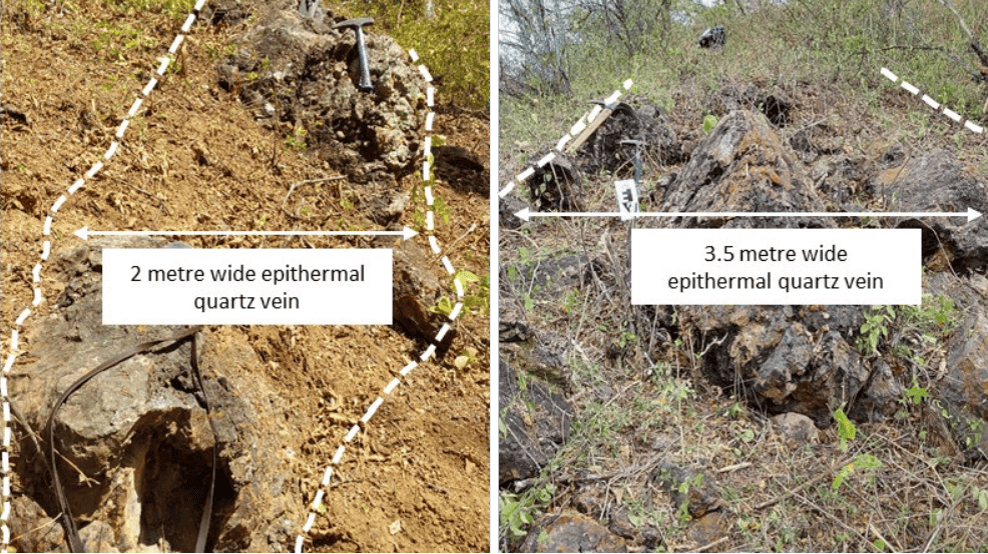The next Fruta del Norte? Titan’s imminent drilling blitz could add serious ounces to 3.12Moz Dynasty gold project

Titan has been focused on unlocking the potential at the Papayal and Trapichillo prospects at the Dynasty project. Pic via Getty Images
- Mapping and surface rock chip sampling confirms several new high-grade gold and silver targets at Dynasty project in Ecuador
- Peak rock chip values returned from additional veins and extensional veins at Papayal and Trapichillo
- Preparations for new drilling at Dynasty now well advanced
Several new high-grade gold and silver resource growth targets have been confirmed at Titan’s Dynasty project in southern Ecuador with most results returning grades more than 20 g/t gold.
In July, Titan (ASX:TTM) unveiled a monster 3.1Moz gold, 22Moz silver maiden resource at the Dynasty project in Ecuador.
That includes a significant high-grade component — 17.3Mt @ 3.77g/t gold and 24.0g/t silver for a contained 2.09Moz gold and 13.33Moz silver.
Over half the resources, positioned along a 9km long corridor, are less than 100m from surface. And with less than half the system tested, the project has blue sky potential.
TTM CEO Melanie Leighton says the company is looking to replicate the success of Lundin Gold (TSX:LUG) and their world-class Fruta del Norte project, an epithermal gold-silver system in southeast Ecuador with many similarities to Dynasty.
“Most of the new high-grade rock chip results with grades in excess of 20 g/t Au have been returned from new veins discovered at Papayal and Trapichillo and highlight the tenor of mineralisation we are targeting as part of our resource growth strategy,” Leighton said.
Lundin’s 9.81Moz gold and 15Moz silver project is now one of the highest grade, lowest cost mines in the world, with total revenue of $841m in 2022.
Dynasty: the next Fruta del Norte
Titan (ASX:TTM) geologists have been undertaking mapping and surface geochemical sampling at the Dynasty project, focusing on the Papayal and Trapichillo prospects, ahead of planned resource growth drilling which is set to commence in mid-September.
Papayal (130,000oz gold, 1.43Moz silver) and Trapichillo (360,000oz gold, 3.71Moz silver) were identified as high-priority resource growth areas following completion of the maiden JORC resource.
Both the Papayal and Trapichillo vein systems exhibit extremely high gold and silver grades, albeit relatively low tonnes, which is largely a function of sparse drilling and lack of exploration.
Recent exploration work programs have largely focused on these prospects which lie at the north-eastern end of the 9-kilometre-long vein system at the Dynasty project.

Delineating high-grade gold-silver in underexplored areas
In recent months, the explorer has been aiming to define further high-grade, high-margin gold-silver resources in these underexplored and to date, sparsely tested areas.
Soil samples have been taken on a 200x100m grid spacing, and in high-priority areas, infill soil sampling has also been completed on a 200x50m spacing to define new targets for exploration and resource growth.
Pleasingly, several resource extensions and new exploration target areas have been highlighted by recent mapping and soil and rock chip geochemistry.
Multi-element soil geochemical results have highlighted several new target areas which exhibit largescale coincident gold, silver, arsenic and antimony anomalism.
Peak values at Papayal include 43.1 g/t gold 1,500 g/t silver, 26 g/t gold and 155 g/t silver, 22.7 g/t gold and 689 g/t silver.
At Trapichillo, results include 26.4 g/t gold and 25.2 g/t silver, 14.5 g/t gold and 100 g/t silver, and 9.96 g/t gold and 240 g/t silver.
Titan says these newly identified high-grade vein systems represent immediate targets and will feature in resource growth drilling programs planned to commence at Dynasty in mid-September.
What’s next?
Further exploration work is being undertaken in the form of mapping and trenching to identify the primary source of soil geochemical anomalism and to understand mineralised vein widths, orientations, and any structural intersection points that may represent high-grade, wide plunging ore shoot targets.
Trenching over these newly defined target areas will provide a much better geological understanding, with geological observations and geochemical information to be incorporated into the design of drilling to optimally test these new high priority targets.
This article was developed in collaboration with Titan Minerals, a Stockhead advertiser at the time of publishing.
This article does not constitute financial product advice. You should consider obtaining independent advice before making any financial decisions.
Related Topics

UNLOCK INSIGHTS
Discover the untold stories of emerging ASX stocks.
Daily news and expert analysis, it's free to subscribe.
By proceeding, you confirm you understand that we handle personal information in accordance with our Privacy Policy.








